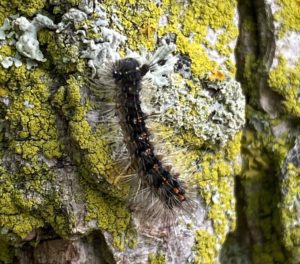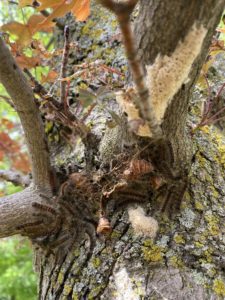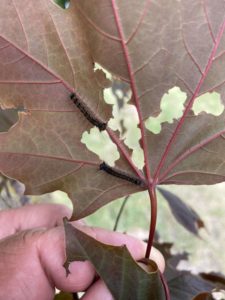The Lymantria dispar dispar (LDD Moth) or as it is more commonly known Spongy moth (formerly the European Gypsy Moth) is a non-native defoliating insect that feeds on a variety of tree species found in the Greater Toronto Area. They are an invasive insect from Europe that were accidentally introduced in North America in the 1860s during an attempt to rear an alternative silk-producing insect. They feed on a wide range of hardwood trees, as well as evergreen trees, but show a preference to oak trees.
Before you start running for the hills because these pests are invading your green spaces, we have put together a quick 101 on everything you need to know about Spongy Moths.
What You Need To Know About Spongy Moths
What Do Spongy Moths Look Like?

Single Spongy Moth Caterpillar
The Spongy Moth (previously known as Gypsy Moths) caterpillars are 50 to 60 millimetres in length. They are dark and hairy, with five pairs of blue dots and six pairs of red dots on the back.
Why Are Spongy Moths A Threat?
Lymantria dispar dispar (LDD Moth) or Spongy/Gypsy moth caterpillars usually congregate in large numbers, eating leaves off your tree over a 1 to 2 month span during the spring/early summer. They can be blown from tree to tree for over a kilometre by the wind, thus spreading these pests across a wider area and creating a larger issue for you to manage.
Each Spongy moth caterpillar can eat an entire square metre of foliage off a tree. This can result in a tree becoming defoliated. A defoliated tree can be weakened substantially and over repeated invasions or combined with other environmental stresses, can result in the tree dying.
Spongy moth caterpillars may also cause allergic reactions, as the small hairs on their body can pierce skin. This can result in a moderate stinging sensation and the pain associated with being stung. Welts or blistering may also be common, but this is dependent on the individual, as everyone reacts differently to being stung.
These pests can also become nuisance when they move onto or lay egg masses on outdoor household items, contaminating the item in the process. Their droppings, which are gooey/sticky, can be messy and unsightly to deal with, making outdoor activity unpleasant especially on paved surfaces, decks or yards.
What Are Common Signs Of Spongy Moths?

Egg sacs and Spongy moth caterpillars on a tree
From late August to early May, you may see the yellowish cottony looking egg masses on trees in your yard. Each egg mass can contain between 100 to 1000 Spongy moth eggs that will be ready to hatch.

Spongy Moth damage on a leaf
The damage from the caterpillars in early May to mid-July is the most noticeable, as it starts with small holes in the leaves and over time, the leaves are soon completely eaten. The most sign of Spongy moths (formerly Gypsy moths) on your property could be the seeing the caterpillars feeding on tree foliage or you may also notice droppings on leaves and the ground. The early instars (the stage in between hatching and moulting into a moth) feed during daytime, so they will be visible on the trees.
How To Prevent Spongy Moths (Formerly Gypsy Moths) On Your Property
Removing as many egg masses as possible during the August to May period can help to significantly reduce the Spongy moth population on your property. It is important to note that it may be difficult to find and access the egg masses, depending upon the height of the tree and the location of the egg masses.
Any kind of burlap sack/material can be wrapped around the tree trunk to capture some Spongy moth caterpillars. Once these pests are on the burlap sack/material, you manually pick them off and place them in soapy water.
If the Spongy moth issue on your property is beyond what you can handle, don’t hesitate to reach out to Orkin Canada. Your experienced Orkin Canada technician will implement a customized Spongy moth program for your trees and property that will ensure your trees are safe. Contact the local pest control experts at Orkin Canada for professional Spongy moth removal you can trust.
Remove pests from your home, and stop them from coming back
We work hard to listen, understand and assess your unique situation. Request a free, no-obligation estimate today for a customized pest program that fits your needs.
Request a Free Home EstimateRequest a Free Business Consultation

You may also like
Becoming A Smart Shopper: How To Avoid Buying A Pest Infestation When Shopping Second-Hand
For many homeowners, second-hand items are slowly becoming the norm. With thrift stores and online marketplace platforms becoming go-to options to acquire various items. Unfortunately, when purchasing products from these sellers, you may not be aware of the environment that these items came from or were stored in, and as a result could inadvertently be bringing a pest issue into your home. To ensure you can recognize the signs of a pest activity on items prior to introducing a new purchase into your home, we have put together a list of the most common pests to watch out for and the items they commonly infest.
Top Pests Expected To Trend In The Winter Of 2023
As the winter of 2023 approaches, it's time to prepare for a different kind of chill – one brought on by the annual influx of winter pests. These uninvited guests can turn your home or business into their winter wonderland. To help you stay ahead of the curve, we've compiled a list of the top pests expected to trend during the winter season of 2023.
Top Pests Expected To Trend In The Summer Of 2023
Warm weather is around the corner, which means pests that have been overwintering or hibernating will wake up as well as non-hibernating pests will start making an appearance outdoors. Being prepared for those spring and summer pests can have an impact on how enjoyable your time will be at home or at work. Using industry leading expertise, we have put together a comprehensive list on the top 8 pests expected to trend in the summer of 2023. This list will provide a deeper dive into the impact that pests can have on your property, along with prevention tips to keep your home or business pest-free.
Calling All Bookworms: Pests To Watch Out For During National Reading Month
While books and pests can sometimes go together, the pests that are attracted to books may not pose a significant health risk for humans, though a few pests can potentially cause allergic reactions in some individuals. Although these pests may not cause you physical harm, they will destroy your books and furniture, and become a visual nuisance in your home. This National Reading Month, Orkin Canada can help you prevent pests from spoiling your fun, so you don’t have to take the term “bookworm” so literally. In honour of National Reading Month, we’ve compiled a list of the top pests to watch out.
Remove pests from your home, and stop them from coming back
We work hard to listen, understand and assess your unique situation. Request a free, no-obligation estimate today for a customized pest program that fits your needs.
Request a Free Home EstimateRequest a Free Business Consultation

